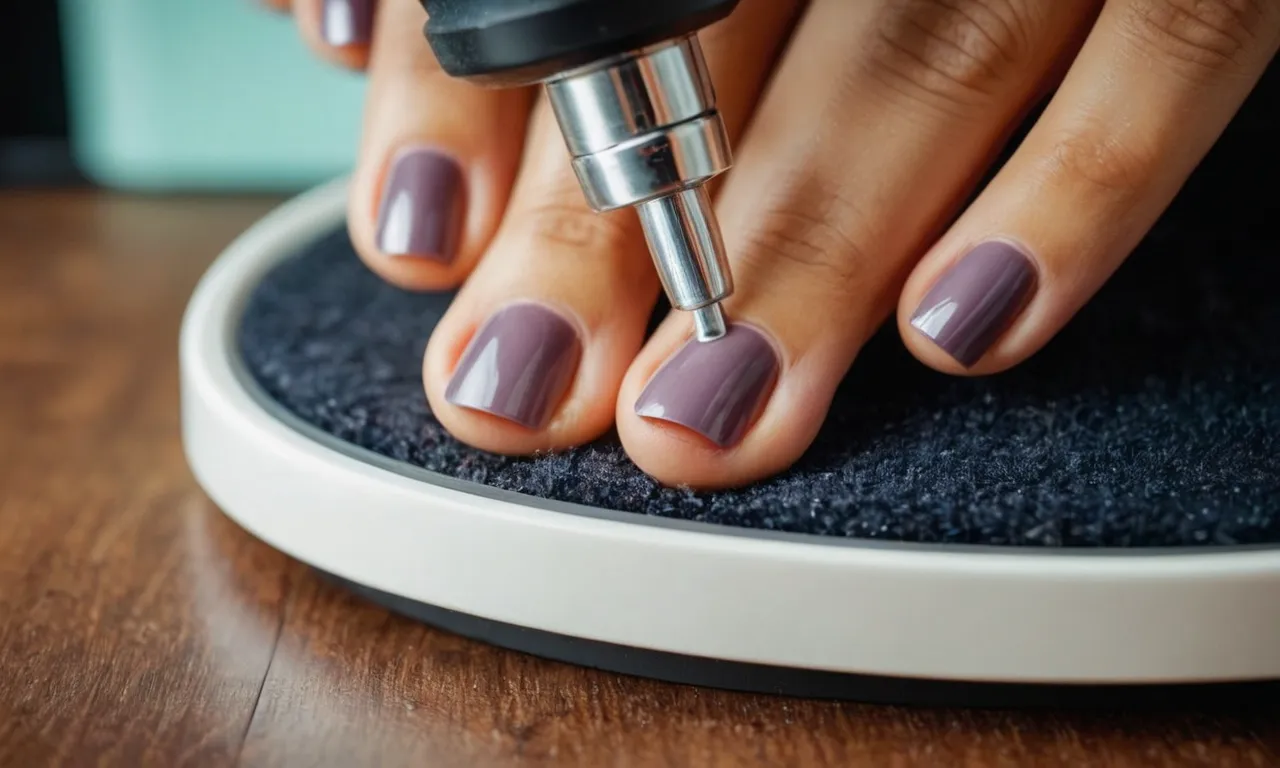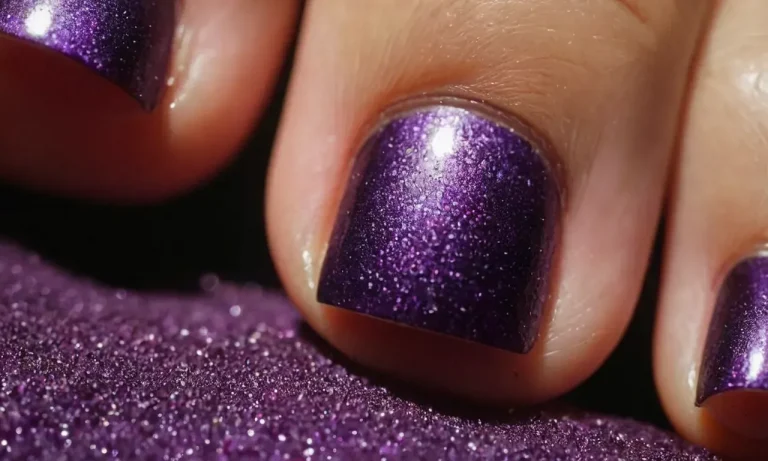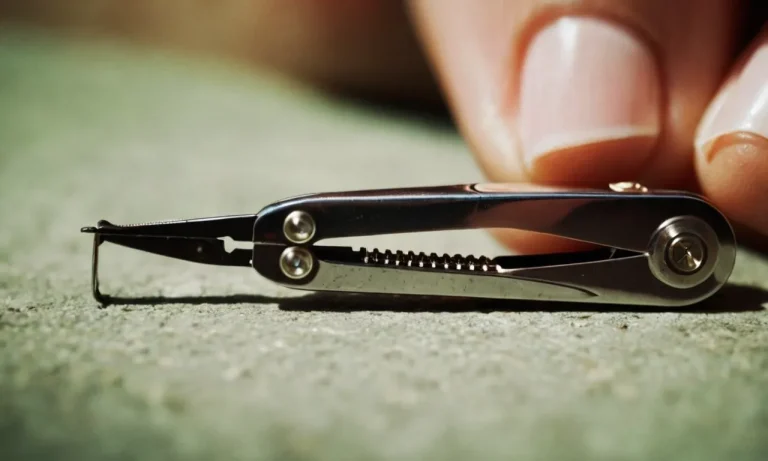Why Do Nail Salons Cut The Sides Of Toenails?
If you’ve ever gotten a pedicure, you may have noticed the nail technician trimming off the sides of your toenails. This isn’t just for aesthetics – there’s an important reason behind this standard salon practice.
If you’re short on time, here’s the quick answer: Nail salons cut the sides of toenails to get rid of ingrown edges and prevent future ingrown toenails, which can be quite painful.
What are ingrown toenails?
An ingrown toenail occurs when the side edges or corners of the toenail grow into the surrounding skin instead of lying flat. This digs into the skin and soft tissue, often causing irritation, redness, swelling, and pain in the toe.
Causes of ingrown toenails
There are several potential causes of ingrown toenails:
- Improperly trimming the toenails – Cutting the nails too short or in a rounded shape encourages the edges to dig into the skin.
- Heredity – Some people are just prone to developing ingrown toenails due to the shape and structure of their nails and toes.
- Pressure on the toes – Tight shoes, socks, or hosiery puts pressure on the toes, forcing the nails to grow into the skin.
- Injury or trauma to the toe – Dropping something on the toe or stubbing it can damage the nail and surrounding skin, allowing ingrowth to occur.
- Nail fungal infections – These can thicken and distort the shape of the nail, increasing ingrown risk.
Symptoms of ingrown toenails
The most common symptoms of an ingrown toenail include:
- Pain – Often the first symptom, ranging from mild to severe pain with pressure on the affected toe.
- Swelling – The toe may become inflamed, red, and swollen around the edges of the nail.
- Infection – Bacteria can enter through the break in skin, causing oozing of pus, foul odor, and increased pain.
Other possible symptoms include bleeding along the nail edge, difficulty walking, nail deformity, and chronic irritation of the toe.
Risk factors for ingrown toenails
Factors that increase ingrown toenail risk include:
- Age – Most common between ages 15 and 40.
- Gender – Men are affected more often than women.
- Foot structure – High arches or flat feet put more pressure on toenails.
- Nail care habits – Cutting nails too short or rounding the edges encourages ingrowth.
- Improperly sized shoes or socks – Too tight footwear presses nails into skin.
- Nail fungus – Can distort nail shape.
- Diabetes – Poor circulation can slow nail growth.
- Obesity – Excess weight also puts pressure on toenails.
- Previous nail trauma or surgery – Weakens nails.
According to an authoritative 2022 study, around 23 million Americans are estimated to suffer from ingrown toenails each year. Proper nail trimming technique and well-fitted shoes and socks can help prevent this painful condition.
How cutting toenail sides helps prevent ingrown nails
Straightening the nail edge
Keeping the toenail edges straight and aligned is key to avoiding ingrown nails, which happen when the nail grows into the skin on the side of the toe. Nail technicians use special clippers and files to trim the nail perfectly straight across, preventing the sides from curving downward and digging into the skin.
This also helps eliminate any jagged or rough edges that can catch on socks or scratch the neighboring toe and cause redness and inflammation.
Trimming protruding nail corners
Technicians also carefully trim down the corners of toenails that stick out too far beyond the toe. Overgrown side corners put pressure on the adjacent toe and can lead to irritation, infection, and future ingrown nails. Clipping off any extra length helps rebalance the nail shape.
For extremely curved nails, the sides may need to be cut quite short in order to remove the portion that has grown into the skin and allow it to reattach properly as it grows out.
Smoothing rough edges
Finally, nail salon tools like electric nail files smooth away roughness on the surface and edges of the nails. Tiny snags and ridges can worsen over time if they catch on fabrics. Filing leaves a clean, even trim that won’t accidentally tear the skin.
This also thins out the nail evenly across the tip, which prevents heavy pressure and embedding into the toe’s skin. Customers may also opt for nail buffing with a shine block after filing for an extra glossy, conditioned nail that grows out beautifully.
According to the American Academy of Dermatology (AAD), overgrown nails account for more than half of ingrown toenails. With regular professional grooming every 2-3 weeks, people can keep their toenails shapely and avoid issues like infection and painful ingrowns.
The nail technicians taper the edges and expertly carve away excess thickness for comfortable, healthy nails.
Proper toenail cutting technique
Using sterilized nail clippers
When trimming toenails, it’s crucial to use clean and sterilized nail clippers to prevent infection. Here are some tips for proper sanitizing:
- Soak nail clippers in rubbing alcohol for 10 minutes before each use. This will kill most bacteria and viruses.
- Use a nail clipper designated only for toenails, not fingernails. Keep them separate.
- Wash hands and feet thoroughly before trimming nails to avoid transferring new bacteria.
- Swipe nail clippers with rubbing alcohol immediately before each clipping.
Studies show that nearly 15% of nail clippers harbor dangerous bacteria like staph and strep if not properly disinfected. Using sterile clippers for each pedicure prevents passing infections between clients or spreading them from feet to hands.
Cutting straight across
Cutting toenails at an angle or rounding the edges can lead to painful ingrown toenails over time. The proper technique is to cut straight across.
- Trim each toenail so it’s flush with the tip of the toe, leaving no white margin.
- Cut straight across in one motion, avoiding angling the edges down into the skin.
- The nail should leave a 90-degree edge that extends just past the toe.
If you trim off the excess toenail rather than rounding it, there will be less opportunity for the nail to grow into the skin and cause discomfort. Straight across cuts also tend to better follow the natural nail lines.
Filing edges smooth
After clipping toenails straight across, use a nail file to gently smooth any rough edges. This helps prevent snagging on socks or scratches.
- Use gentle, even downward strokes along each edge to round slightly.
- Do not file too much or create roughness in the nail plate.
- Be extra careful filing brittle or discolored nails, like those impacted by fungus.
Filing also thins out the nail edge slightly, further reducing the chances of ingrown toenails developing over time. Take care not to file too aggressively or it can weaken the nail overall. Proper technique helps soften the edges for a comfortable fit in shoes.
When to see a podiatrist for ingrown nails
Moderate to severe pain
Ingrown toenails can cause discomfort, redness, swelling, and even infections, but often they may be managed at home. However, if the pain becomes moderate to severe, that is usually a sign it is time to have a podiatrist take a look.
A podiatrist can numb the area and remove parts of the nail pressing into the skin to provide relief. This can prevent long-term complications like thickened nails or chronic infections.
On a scale of 1 to 10, pain levels of 4 or higher when walking or bearing weight on the toe indicates advanced progression of the ingrown nail. Swelling, redness, oozing of pus or blood, and pain interfering with daily activities also signals it is best to seek professional podiatry help.
The sooner ingrown nails are treated by a specialist, the lower the likelihood of surgery being necessary down the road.
Signs of infection
Ingrown toenails opening the skin provide an entry point for bacteria and fungus to cause infection. Signs to be on alert for when monitoring an ingrown nail include:
- Increasing redness, warmth and swelling around the nail
- Green or yellow colored drainage with a foul odor
- Fever
These symptoms indicate a secondary infection is developing, likely from staphylococcus or streptococcus bacteria. However, serious infections can also be caused by antibiotic-resistant bacteria like MRSA.
At this stage, oral antibiotics or anti-fungal medications will be necessary, which a podiatrist can prescribe after properly cleaning and draining an abscess if present.
Chronic ingrown nails
Ingrown nails that keep growing back despite home treatment or happen repeatedly are considered chronic. This causes nuisance symptoms and puts you at ongoing infection risk. A podiatrist has tools to permanently prevent recurrence through removal of the offending nail edge and chemical cauterization to stop regrowth.
Here is a comparison of complications that can happen if chronic ingrown nails are left untreated versus reasons to see a podiatrist:
| Complications if Untreated | Benefits of Podiatrist Treatment |
|---|---|
|
|
As demonstrated, visiting a podiatrist promptly when complications arise from an ingrown toenail can prevent small problems from becoming serious foot conditions. Catching infections early and surgically widening the nail fold means less drastic treatments are required for clearance.
Caring for toenails between pedicures
Trimming nails regularly
Getting regular pedicures is important for having healthy, beautiful toenails. However, it’s also crucial to care for your nails in between appointments. One of the most important things is to trim your toenails regularly, about once a week.
This helps prevent them from becoming too long or thick, which can lead to ingrown nails or fungal infections.
Here are some tips for properly trimming your toenails:
- Soak your feet in warm water for 5-10 minutes to soften the nails before trimming.
- Use sharp, sterilized nail clippers designed specifically for thicker toenails.
- Trim nails straight across, avoiding rounding off the edges.
- Never cut into the corners of the nails, as this can lead to ingrown toenails.
- Smooth any rough edges with an emery board or nail file.
Trimming regularly helps you maintain that fresh from the salon look and feel. Just don’t trim too short! Leave a tiny bit of white nail at the tip.
Applying moisturizer
Dry, brittle toenails are more prone to cracking and breaking. That’s why it’s important to keep nails well-moisturized between pedicures. Apply a rich foot cream or thick moisturizer daily, massaging it into the nails and cuticles.
Look for products containing hydrating ingredients like shea butter, glycerin, and vitamin E.
You can also do a weekly deep conditioning treatment by applying petroleum jelly, olive oil, or coconut oil onto nails, and covering with cotton socks overnight. The moisturizing oils will penetrate the nails, leaving them strong and flexible.
Exfoliating once or twice a week also helps keep nails in top shape. Use a foot scrub containing alpha hydroxy acids or gentle scrubs like oatmeal, salt, or sugar. This removes dead skin cells and improves circulation, promoting healthy nail growth.
Wearing properly fitted shoes
The health of your toenails goes beyond just caring for them directly – the shoes you wear play a big role too.
Here’s how to choose footwear that supports healthy nails:
- Opt for shoes with a wide toe box, which prevents crowding and rubbing against the nails that can cause damage.
- Avoid heels higher than 2 inches, which shifts weight unnaturally onto the toes and applies excess pressure.
- Look for shoes with cushioned footbeds and those made of natural materials like leather to absorb moisture and keep feet ventilated.
- Alternate between different pairs to allow them to fully air out and dry between wears.
Wearing properly fitted, breathable shoes keeps your feet happy and helps you put your best foot forward in between pedicures! Just remember to get those piggies polished again in 4-6 weeks.
Conclusion
Ingrown toenails can be quite troublesome, but regularly having your toenails professionally trimmed and edged at the salon can help prevent this painful condition. Understanding why nail techs cut your toenail sides helps you appreciate this standard pedicure practice.
Next time you get a pedicure, you can relax knowing that the toenail trimming is not just for looks – it’s an important part of keeping your feet healthy and free of ingrown nails.







